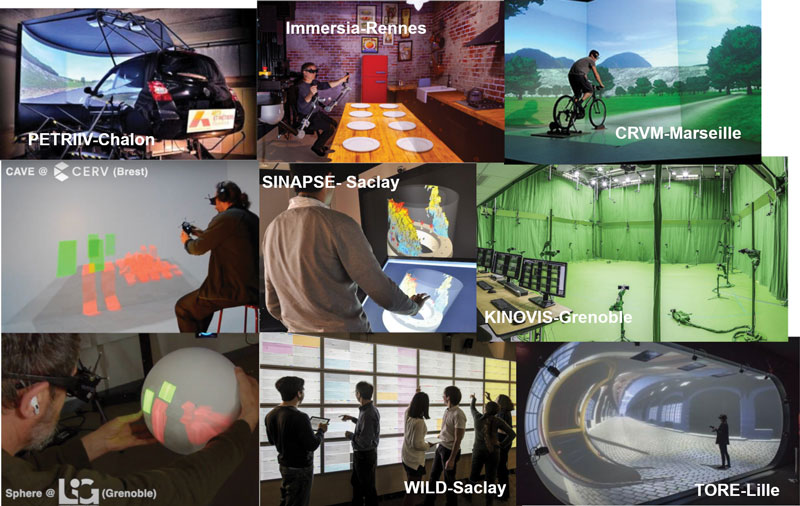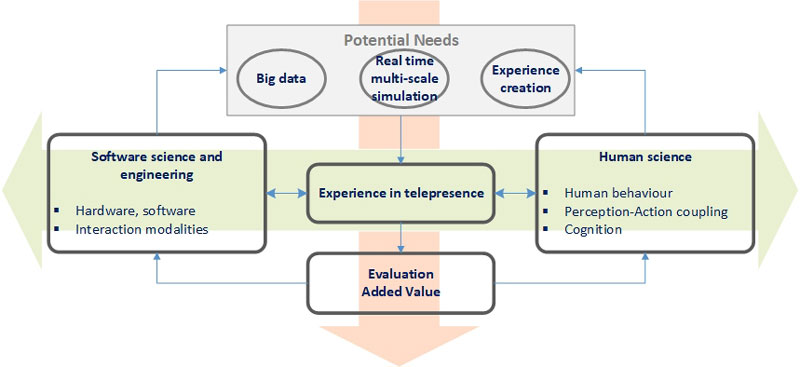by Alexandre Kabil (Université Paris-Saclay, CNRS, Inria), Ronan Gaugne (Univ Rennes, Inria, CNRS, IRISA), Michel Beaudouin-Lafon (Université Paris-Saclay, CNRS, Inria)
The French National Research Infrastructure CONTINUUM is a unique consortium of 30 platforms located throughout France for advancing interdisciplinary research between computer science, the humanities and social sciences. Through CONTINUUM, 37 research groups develop cutting-edge research focusing on visualisation, immersion, interaction and collaboration, as well as human perception, cognition and behaviour in virtual/augmented reality.
Launched in 2021, the CONTINUUM research infrastructure [L1] features 30 platforms ranging from large immersive CAVEs to ultra-high resolution wall-sized displays combined with a variety of sensors to capture users’ activity and enable rich interactions (see Figure1).

Figure 1: Example of the diversity of CONTINUUM platforms. .© Inria/Photo H. Raguet for WILD picture.
CONTINUUM enables a paradigm shift in the way we perceive, interact and collaborate with complex digital data and digital worlds by placing the human at the centre of data processing workflows. The research activities of the network cover human-computer interaction (HCI), virtual, augmented and mixed reality (XR), visual and immersive analytics (InfoViz), collaborative virtual environments (CVE), computer supported collaborative work (CSCW) and High Performance Computing (HPC) for Scientific Visualizations (SciViz).
The infrastructure provides scientists, engineers and industrial users with a network of high-performance visualisation and immersion platforms for observing, manipulating, understanding and sharing digital data, multi-scale simulations and virtual or augmented experiences. The platforms support remote real-time collaboration through dedicated software and hardware. They also feature mobile equipment such as head-mounted displays that can be loaned to external users to facilitate access to these technologies.
CONTINUUM is organised along two axes:
- Interdisciplinary research on interaction, in collaboration between computer science, the humanities and social sciences, in order to increase knowledge and develop new solutions in the field of human-centred computing.
- Deployment of tools and services to meet the needs of scientists and engineers for accessing big data, simulations and virtual/augmented experiences in fields such as mathematics, physics, biology, engineering, computing, medicine, psychology, didactics, history, archaeology, sociology, etc.
The first axis enables a continuum of experiences spanning the wide range of platform capabilities and the diversity of potential users of the infrastructure: device continuity (from headset to screens and CAVEs), interaction continuity (from desktop interaction to full-body tracking), collaboration continuity (from real-time to asynchronous collaboration), and expertise continuity (from novice to expert user). The second axis addresses the needs of three main classes of uses: big and/or complex data (from capture to representation), simulation (from multi-scale physics simulation to real-time interactive environments) and virtual or augmented experiences (from design to controlled experiments) (see Figure 2).

Figure 2: Scope of the CONTINUUM infrastructure.
At the technical level, CONTINUUM faces a few technical challenges to support rich collaborative interaction and visualisation across heterogeneous platforms. Interconnecting the platforms requires high-bandwidth networking and overcoming the cybersecurity measures imposed by the different partners, as well as agreeing on converting between file formats and protocols that are often incompatible across applications. For example, WebRTC works well for streaming audio and video between web applications running on large wall-sized displays, but is not standard yet for immersive applications and scientific visualisation tools. Coupling motion tracking and biosensor data with virtual environments to let users interact remotely with complex 3D data visualisations generated by a computing cluster while streaming audio and video requires coordination and interoperability at different levels of the infrastructure.
CONTINUUM’s broad geographical and scientific coverage enables the dissemination of the network’s know-how to the economic and social environment, in collaboration with innovation transfer players. Specific business models are being developed to let both academics and private users access the equipment and the cutting-edge expertise of the partners.
CONTINUUM is led by CNRS [L2], the French National Centre for Scientific Research. Two other national institutes participate in the network: Inria [L3], through the three research centres of Rennes, Grenoble and Saclay, and CEA [L4], through its Saclay research centre; as well as 19 universities and engineering and higher education schools. Over 160 researchers and Ph.D. students from 37 research groups directly participate in the network, and close to 600 Master-level students access the platforms annually.
In summary, CONTINUUM provides a key missing link between the current e-infrastructure of data centres, computing facilities and cloud services on the one hand, and human intelligence and expertise on the other. More than ever, we need collective human intelligence to harness the power of computation and tame the data deluge. More than just a “human in the loop”, we need the human to be in control, and we need to provide them with proper tools to exert their control.
For centuries, natural sciences have developed scientific instruments to observe hidden phenomena, conduct experiments and make discoveries. Similarly, CONTINUUM is a digital instrument to explore the digital world. By developing both the instrument itself and using it in a variety of application areas, CONTINUUM will foster interdisciplinary research at an international level to better understand how to interact with the digital world and enable advances in other sciences and engineering fields.
CONTINUUM represents an opportunity to develop a European-scale research infrastructure in the domain of advanced visualisation, interaction, and collaboration in XR following the example of the former FP7 European infrastructure VISIONAIR [1], which gathered 25 partners from 11 countries, and enabled 25 internal projects to improve visualisation and interaction technology protocols.
We are currently running innovative PoCs such as a project to design collaborative and immersive environments for heterogeneous artistic modalities between Immersia-Rennes and Tore-Lille (see Figure 1), and a project on asymmetric collaboration between immersive virtual reality and spatial augmented reality, as shown in the two images on the left of Figure 1, with CERV-Brest and Sphere@LIG-Grenoble.
This work was supported by French government funding managed by the National Research Agency under the Investments for the Future programme (PIA) grant ANR-21- ESRE-0030 (CONTINUUM).
Links:
[L1] http://continuum.website
[L2] https://www.cnrs.fr/en
[L3] https://www.inria.fr/en
[L4] https://www.cea.fr/english
Reference:
[1] A. Kopecki, et al., “VISIONAIR, VISION advanced infrastructure for research,” Procedia CIRP, vol. 2, no. 2, pp.40–43, 2011.
Please contact:
Alexandre Kabil
Université Paris-Saclay, CNRS, Inria, France
Ronan Gaugne
Univ Rennes, Inria, CNRS, IRISA, France










